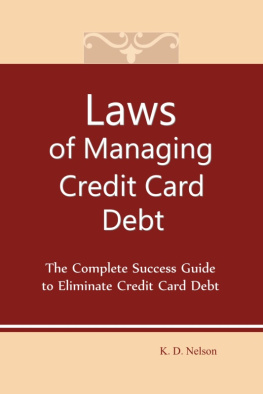Acknowledgments
There have been so many who have helped guide me through lifes ups and downs. Of all of them, I would be incredibly remiss if I didnt take the time to thank John Cummuta, my father-in-law. Without him, hundreds of thousands of people would have never learned what true debt elimination is all about, including me. He started the revolution; I only hope to continue the battle.
Additionally, I absolutely must take the time to thank my wonderful wife, Stacyann. In writing this book, Ive had to hide away many nights, leaving her to juggle our five munchkins. Without her never-ending support this book would still be only an idea. I doubt Ill ever truly deserve you.
I also want to thank Chip MacGregor, my agent; Debra Englander, my editor; Kelly OConnor, my developmental editor; and all the great folks at John Wiley & Sons who made it possible for this idea to become a reality.
Special thanks to all the folks Ive had the pleasure of working with over the years, especially Tammy, Lisa H., Machelle, Mel, Maureen, Lisa F., Rob, Bob, Karen, Lisa W., Mickey D., Amy, Lynn, Missy, Annette, Verna, Tonyha, and all the rest (you know who you are). You are all true soldiers!
Finally, I must give praise, honor and glory to Jesus, my King. Thanks to him, this lump of clay may be able to help a few peopleand, if Im lucky, bless a few as well.
ANTHONY MANGANIELLO
APPENDIX A
The Cash-FLOW Analysis Work Sheet
In this Appendix, we review the components needed to complete your Cash-FLOW Analysis work sheet, beginning with how to calculate your monthly net income and ending with how to calculate your expenses.
Calculating Your Monthly Net Income
In this section, you will learn how to calculate your monthly net income if you are paid weekly, biweekly, or on the 1st and 15th of the month.
Are You Paid Weekly?
A common mistake many people make when calculating their monthly net income is to multiply their weekly net pay by 4 (assuming since there are four weeks in a month, this should be accurate). However, for folks earning a weekly paycheck, there usually are four months in each year that have an extra pay period (depending on the day of the week youre paid).
Lets look at the inaccurate way to calculate your net monthly income when youre being paid $500 in net pay weekly.
$500 4 = $2,000
To accurately calculate your monthly net income, you need to multiply your weekly net pay by 52 (the number of weeks in the year), and then divide the result by 12 (the number of months in the year). Heres an example:
Weekly Net Pay = $500
$500 52 = $26,000
$26,000 12 = $2,166.67
Monthly net income for an individual earning $500 in net pay per week equals $2,166.67
Are You Paid Biweekly?
As in the case with those earning a weekly paycheck, a common mistake biweekly paycheck earners make when calculating monthly net income is to multiply their net biweekly pay by 2, as if they received two checks each month, or 24 each year. However, if youre paid biweekly, then youll actually receive 26 checks during the year.
Lets look at the inaccurate way to calculate your net monthly income when youre being paid $1,200 in net pay biweekly.
$1,200 2 = $2,400
To accurately calculate your monthly net income, you need to multiply your biweekly net pay by 26 (the number of biweekly pay periods in a year), and then divide the result by 12 (the number of months in the year). Heres an example:
$1,200 26 = $31,200
$31,200 12 = $2,600
Are You Paid on the 1st and 15th?
If youre being paid on the 1st and the 15th, or the 14th and the 28th, or on any two dates of each month, then youre actually going to receive only 24 checks during the year. Should that be the case, then you can multiply the net pay from one of those checks by 2.
Note: The key to calculating your net monthly income is to make sure youre calculations include all pay youll receive within the year.
If youre paid by commission and your income is irregular, do your best to average your income over the 12-month period necessary.
TOTAL MONTHLY NET INCOME
Only four spaces are provided here. Be sure to include any/all forms of income your household may be experiencing. Whether your household earns full-time, part-time, or investment income that youre currently using to live on, all of that income needs to be accounted for here. Feel free to add any additional sources of income necessary.
Calculating Your Monthly Living Expenses
Most of the expenses listed in the work sheet are assessed on a monthly basis. However, there are some, like water bills, that are assessed quarterly. As you gather your expense information, note the frequency with which you must remit payment, and be sure that any amounts are adjusted to reflect the appropriate monthly amount.
These expense categories are listed in alphabetical order and the list should not be considered all-inclusive. You may have additional monthly expenses not listed here. Be sure to include all regular monthly expenses you incur.
TOTAL MONTHLY LIVING EXPENSES
This expense list is not exhaustive. You may have additional expenses you need to account for that are not listed here. Be sure to include any/all monthly living expenses necessary. Also, be sure to record them in their appropriate monthly amounts.
Calculating Your Total Monthly Debt Payments
When calculating the total you pay each month for all your secured and unsecured debt payments, be sure to include only the minimum amount due for each account. Sometimes, you may be behind on an account and additional funds may be required to bring you current. Since this is usually only a temporary matter, you should include only the amount of payment for each account as each account was caught up.
For example, if the minimum amount due on a particular account is $125, but youre behind on that account by two months, your current amount due may be $375 (two back payments plus the current payment). Paying this amount would obviously get you caught up and back on track to remitting the normal monthly payment of $125.
However, entering the current amount due in your CFA would skew its results by the additional $250 you would be remitting on that account for this one month. In doing your CFA, what youre after is a clear picture of your cash flow
if all of your payments are being made on time. If you have an account (or accounts) requiring a larger current payment, there are two options regarding how to address this problem:
1. Enter only the required amount due as if all accounts are current. If after completing your CFA in this manner, you have a healthy to adequate Cash-FLOW Index (CFI), youll attempt to use your CFI to get yourself caught up on any past-due accounts before applying your CFI to the debt elimination portion of your Debt-FREE Millionaire Plan.
2. If after youve completed your CFA as outlined in #1, you find your CFI is adequate to poor, then youll need to determine your CFI two ways.
1. With the amounts for the minimum amount due for each past due account (which you would have just completed).
2. With the total current amounts due for any past-due accounts.
The purpose of completing your analysis in this way is to determine the condition of your CFI for both sets of circumstances. Being behind on payments without the ability to get caught up may mean your cash flow requires the assistance of a debt-relief service provider (as outlined in Chapters 6 through 9). Only the appropriate service provider would be able to assist you in determining if its service can assist you.







